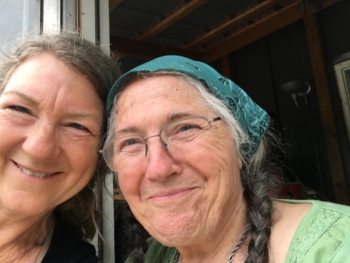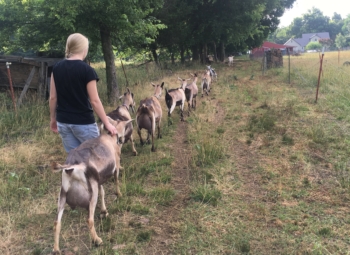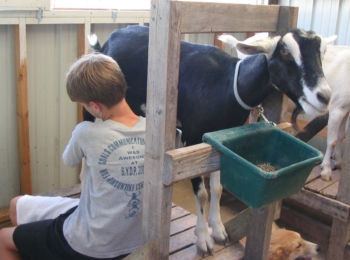January is Farmer Appreciation Month at NCAT, and some of the farmers and ranchers we especially value are those who make the effort to pass along their hard-won knowledge to beginners. NCAT Livestock Specialist Linda Coffey recently lost one of her farming mentors and took the opportunity to document how significantly this friend influenced her life.
On December 21, 2024, family and friends gathered in Fayetteville, Arkansas, to celebrate the extraordinary life of Mrs. Janice Neighbor. Many people shared stories, and I loved hearing them all, but I couldn’t share mine then. I knew I would cry and stumble over words and not be able to adequately say what she has meant to me and my family for the past 25 years. But I would like to share here what Janice meant to me, in hopes that readers will be reminded of mentors in their own lives, and of people they could mentor, too, to help make the world a better place, as she did.

NCAT specialist Linda Coffey (left) and her friend and farming mentor Janice Neighbor (right). Photo: Linda Coffey, NCAT
My path crossed with Janice because of dairy goats. I had the idea that if we had a couple of dairy goats to milk, we would save money on our grocery bill. Our family of six drank a lot of milk. I mentioned this to a friend who replied that I ought to talk to Janice Neighbor, because her son was in his last year of 4-H and the family would be selling a lot of goats.
I found Janice at the kitchen cabin at Prairie Grove Battlefield State Park, where she was engaged in a reenactment. I was fascinated with the living history she was enacting, cooking with cast iron in the fireplace of the cabin, wearing period clothing, teaching people who came in about the Civil War era, and sharing delicious rolls that she had baked in a Dutch oven. We arranged to meet, and she began mentoring me about goats right from the start.

Hannah Coffey leads the family’s herd of milk goats to the barn for milking time. Photo: Linda Coffey, NCAT
She and her son had spent years breeding high-quality goats. She gave some to us with the stipulation that we must join 4-H and show the goats at the county fair. She promised to help with that by forming a dairy goat club for others who wanted to show, so we could learn together. That is how we met others who had similar interests. Janice was THE person responsible for connecting the Coffey family to the fair community. The last 25 years would have been so different if she hadn’t cared for and worked with us. I am so grateful!
Janice showed so much patience. We had so much to learn, and she guided us through joining the American Dairy Goat Association, getting papers transferred, applying for our farm name, applying for our herd tattoo, filling out registration papers, filling out fair entry forms, learning to fit and show and properly care for these beautiful, useful animals. She taught us what we needed to know, and we entered our first fair.
It is so much more fulfilling to be a participant than to be a spectator! And it was amazingly helpful having the pro introduce us to other experienced people in the dairy goat barn, having her encourage us each step of the way and cheer us on as the goats that originally were her son’s won more ribbons for our children and our farm. The fair that year, and every year that we participated, was my favorite week of the year, and Janice gave that to us. She helped us learn all about the Dairy Goat Barn customs, the premium sale, and the fun event where the goats and children dressed up and competed. And she was there, cheering us on and celebrating with us.
The joy of being part of this! It was great for me and for our kids, and we always did well, having started with really nice goats and taken Janice’s recommendations about where to acquire more breeding stock. It was satisfying and fun, and we would never have done it if she hadn’t put that requirement on us and then taught us how.

John Coffey takes a turn at milking one of the family’s milk goats. Photo: Linda Coffey, NCAT
The dairy goats brought other benefits to our family, beyond the fair. Our kids developed a solid work ethic with twice-a-day milking, and the milk itself fed our family, local customers, and the pigs, calves, and lambs we also raised. We learned to make cheese – she guided us there, too.
We took goats to Farm Friends, a fun event where over 1,000 school children attend, and there’s a free bean supper that evening for the community. Janice was always there, too, spinning all day with her guild and providing cornbread for the evening meal.
Janice also helped us with our sheep and got us involved in Sheep to Shawl. She got her entire spinners’ guild to spin our Gulf Coast wool for Sheep to Shawl, and I loved seeing what they created.
She was also such a good cook and gardener. She knew so much about culinary and medicinal herbs. She knew and grew at least ten basil varieties, for example, and the seed collection she and her husband developed is so impressive. She was a Master Naturalist as well as a Master Gardener, Master Canner, and knowledgeable in all the homesteading arts. I can’t capture everything that was special about her. I haven’t mentioned her humor, her colorful expressions, her vast knowledge of history, medicine, livestock, fiber arts, food preservation, indigenous knowledge, and more. I haven’t helped you picture her beautiful, kind smile, her enthusiasm for life and for people and for nature. You can’t see how she enjoyed all the good things, how she encouraged so many people every day, how she could be very blunt and straight-forward when the situation called for it, or how she’d lived so MUCH in her lifetime.
But her kindness and love for our family are what I will miss most. She got to know each of our children, celebrated our successes, and shared her teaching experience. She gave me great support and advice, even to the last time I saw her, literally on her deathbed, when she still cared and gave me words of wisdom.
I thought I had more time. I regret that I never took the time to just go hang out all day and learn. I would have had to go every day for a long time to just get the tip of the iceberg! I always thought I would do that “later.” My advice for you is this: if you know someone you admire and love, prioritize spending time with them, no matter how busy you are. If you have the chance to be a participant instead of a spectator, do it! It’s much more fun. If you have a mentor, thank them. If you are a mentor, I thank YOU: you are changing lives and making the world a better place, as my precious friend Janice did.
Beginning farmers often connect with mentors through formal mentorship programs like Marbleseed’s Farmer-to-Farmer Mentorship Program, Quivira Coalition’s New Agrarian Program, and Practical Farmers of Iowa’s Labor4Learning. Similarly, structured learning opportunities like the ones listed in ATTRA’s Internship Hub can help beginners connect with experienced agricultural practitioners.
This blog is produced by the National Center for Appropriate Technology through the ATTRA Sustainable Agriculture program, under a cooperative agreement with USDA Rural Development. ATTRA.NCAT.ORG.


